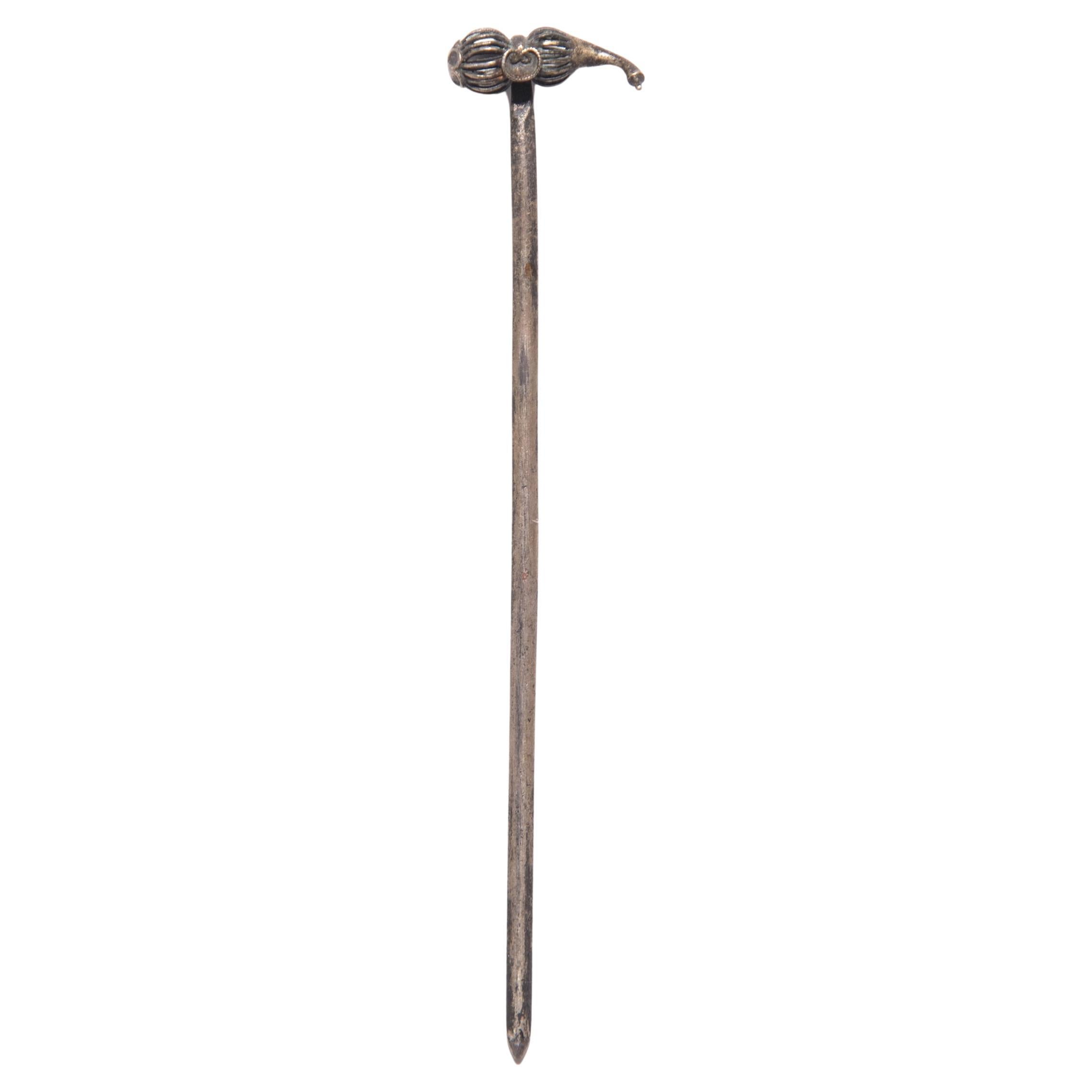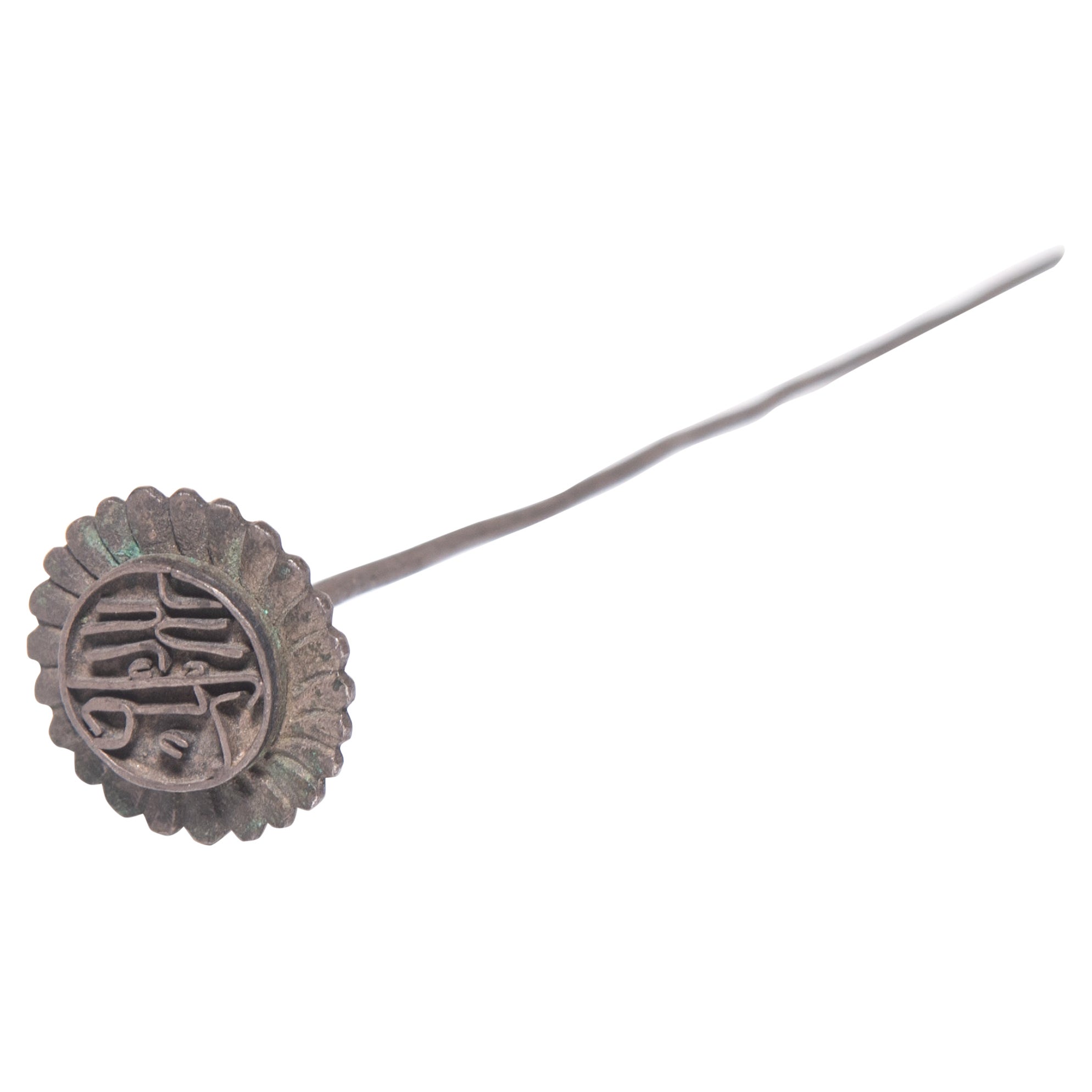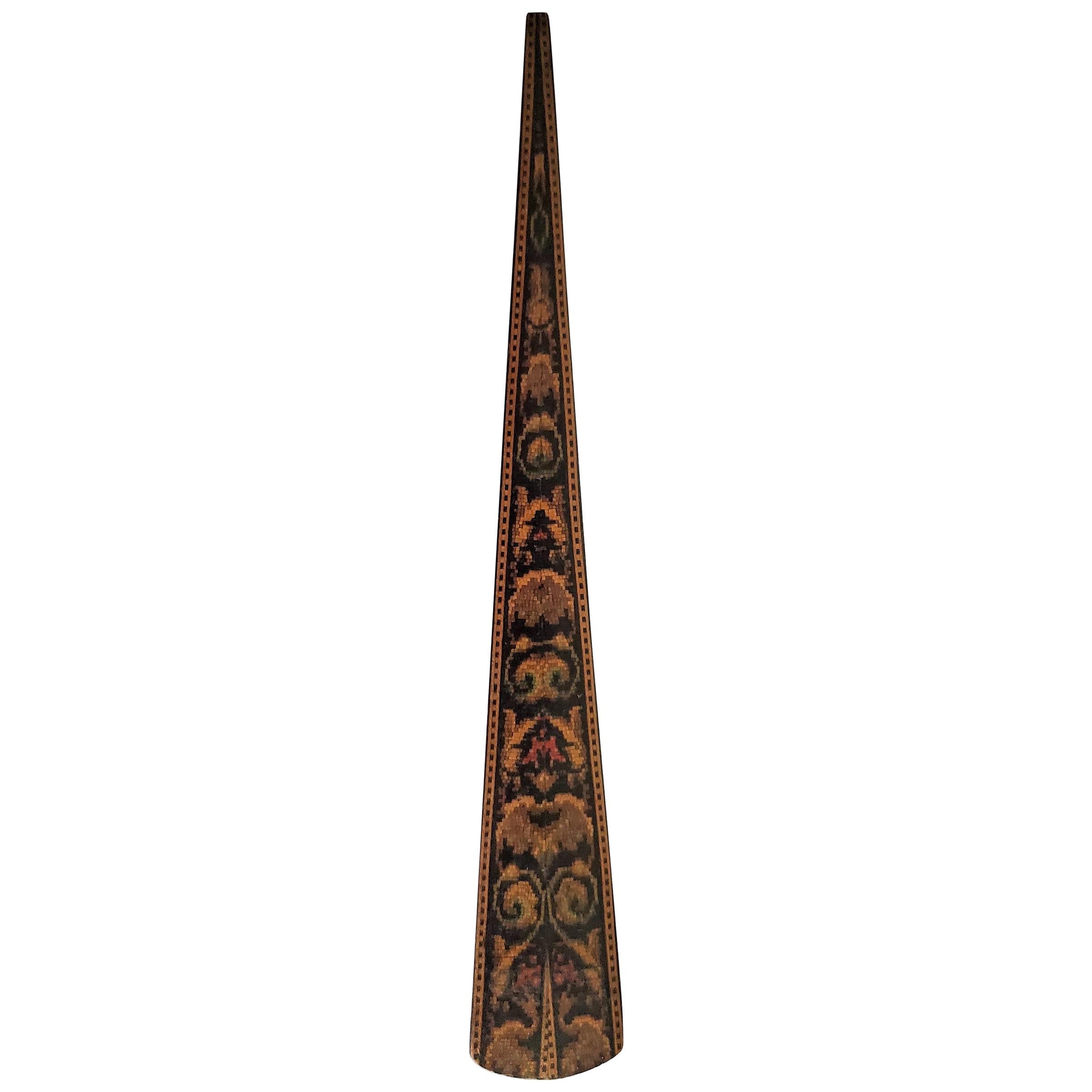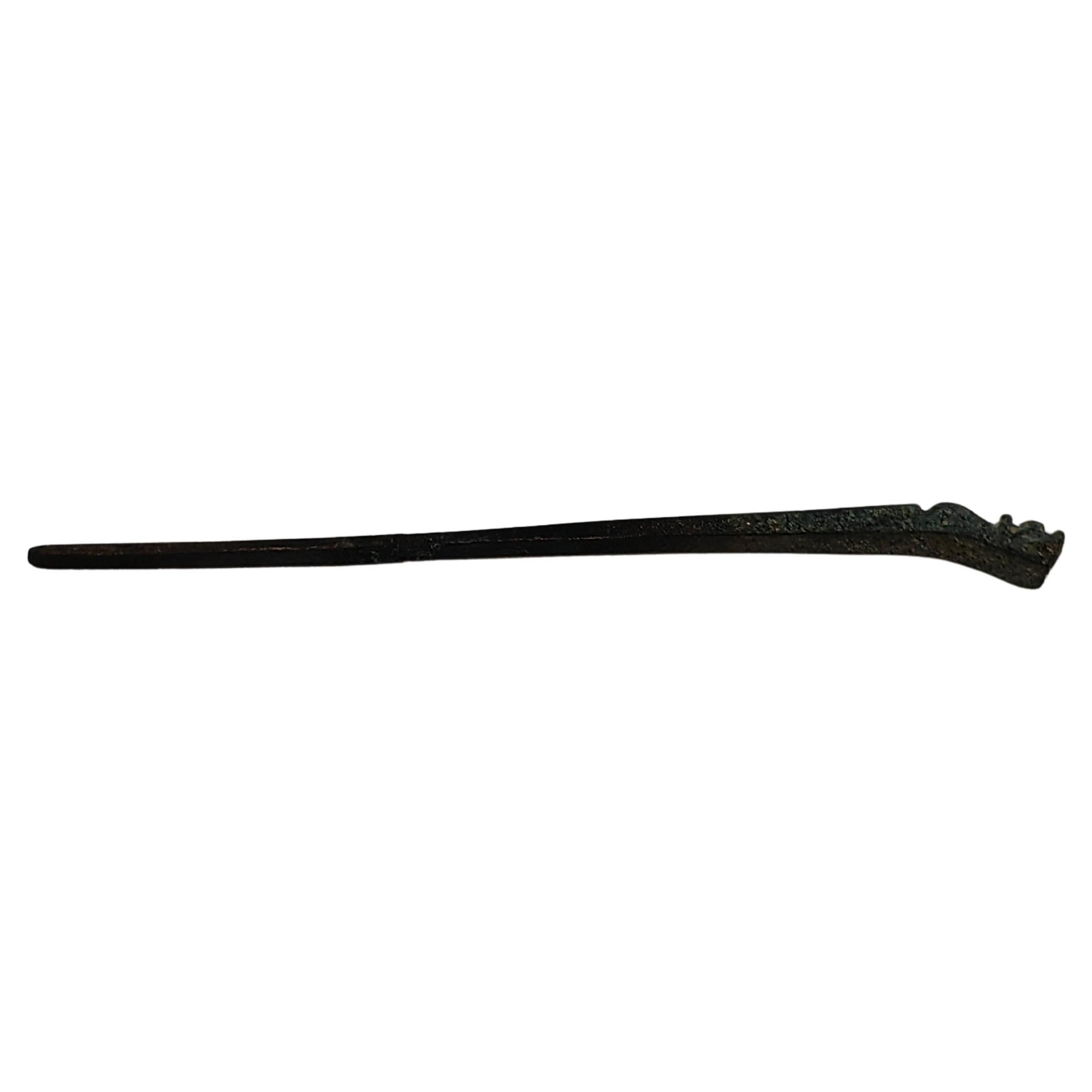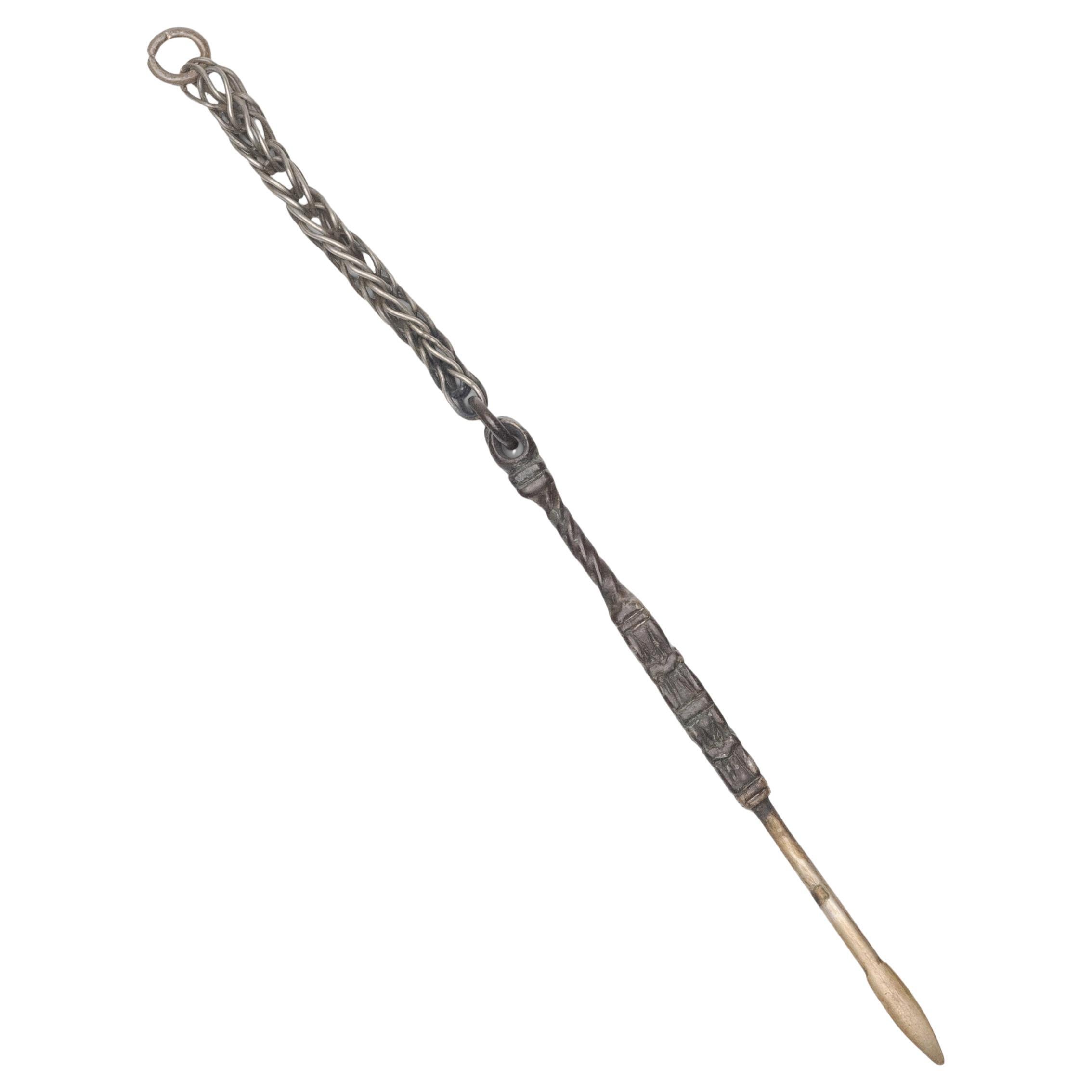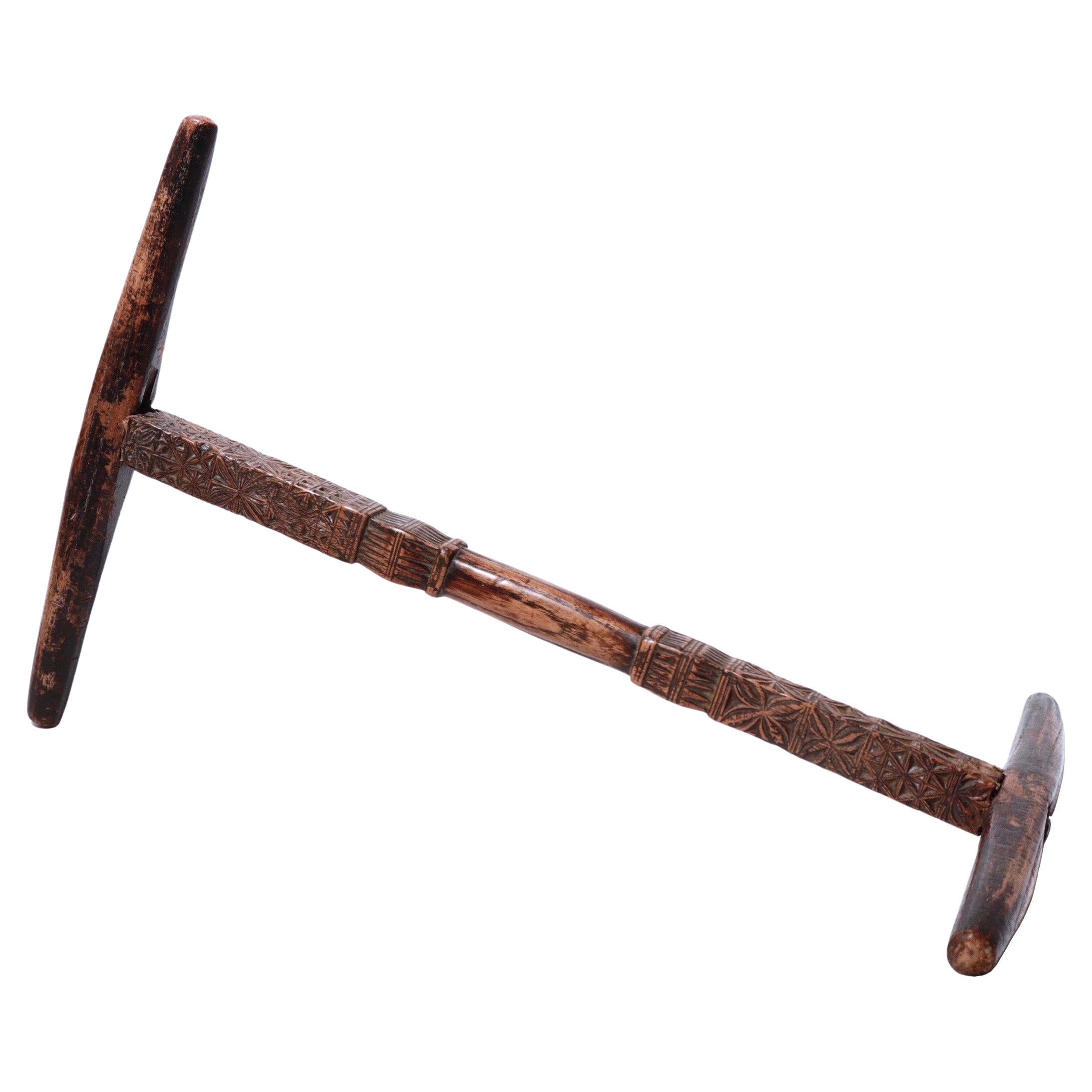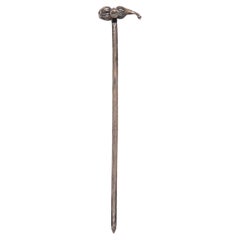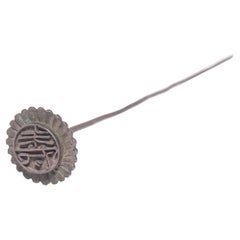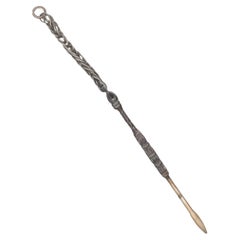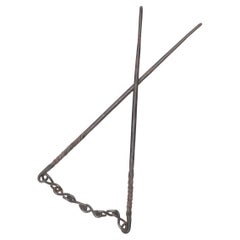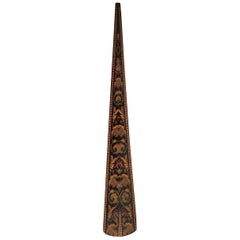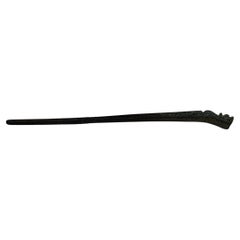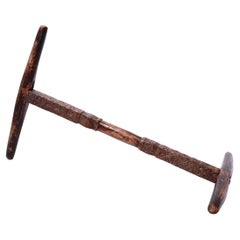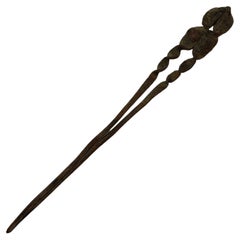Want more images or videos?
Request additional images or videos from the seller
1 of 5
Chinese Good Fortune Hairpin, c. 1900
$98
£74.93
€86.30
CA$137.33
A$153.31
CHF 80.33
MX$1,876.71
NOK 1,020.24
SEK 961.96
DKK 644.06
Shipping
Retrieving quote...The 1stDibs Promise:
Authenticity Guarantee,
Money-Back Guarantee,
24-Hour Cancellation
About the Item
Although eyes were certainly drawn to the high, fan-shaped headdresses that Qing-dynasty women affixed to back of their heads, it was the finishing touch of a hairpin or two that completed the look. This silver hairpin ends in a round floral medallion framing the decorative Fu (?) character for "good fortune." Attached to the front of a fine lady’s coiffure, this little hairpin would have brought her blessings of luck and prosperity.
- Dimensions:Height: 5 in (12.7 cm)Width: 1 in (2.54 cm)Depth: 1 in (2.54 cm)
- Style:Qing (Of the Period)
- Materials and Techniques:
- Place of Origin:
- Period:
- Date of Manufacture:circa 1900
- Condition:Wear consistent with age and use.
- Seller Location:Chicago, IL
- Reference Number:Seller: NN008A1stDibs: LU820026667202
About the Seller
5.0
Platinum Seller
Premium sellers with a 4.7+ rating and 24-hour response times
Established in 1997
1stDibs seller since 2006
1,695 sales on 1stDibs
Typical response time: 1 hour
- ShippingRetrieving quote...Shipping from: Chicago, IL
- Return Policy
Authenticity Guarantee
In the unlikely event there’s an issue with an item’s authenticity, contact us within 1 year for a full refund. DetailsMoney-Back Guarantee
If your item is not as described, is damaged in transit, or does not arrive, contact us within 7 days for a full refund. Details24-Hour Cancellation
You have a 24-hour grace period in which to reconsider your purchase, with no questions asked.Vetted Professional Sellers
Our world-class sellers must adhere to strict standards for service and quality, maintaining the integrity of our listings.Price-Match Guarantee
If you find that a seller listed the same item for a lower price elsewhere, we’ll match it.Trusted Global Delivery
Our best-in-class carrier network provides specialized shipping options worldwide, including custom delivery.More From This Seller
View AllChinese Double Gourd Hairpin, c. 1900
Located in Chicago, IL
Although eyes were certainly drawn to the high, fan-shaped headdresses that Qing-dynasty women affixed to back of their heads, it was the finishing touch of a hairpin or two that com...
Category
Antique Late 19th Century Chinese Qing Collectible Jewelry
Materials
Silver
Chinese Longevity Hairpin, c. 1900
Located in Chicago, IL
Although eyes were certainly drawn to the high, fan-shaped headdresses that Qing-dynasty women affixed to back of their heads, it was the finishing touch of a hairpin or two that com...
Category
Antique Late 19th Century Chinese Qing Collectible Jewelry
Materials
Silver
Petite Chinese Opium Tool Charm, c. 1900
Located in Chicago, IL
A small Chinese chatelaine tool set strung with a single brass spoon. Suspended from one's clothing at the shoulder, back, or waist, a tool set such as this was used for a variety of...
Category
Early 20th Century Chinese Qing More Asian Art, Objects and Furniture
Materials
Brass
Pair of Chinese Twisted Iron Coal Chopsticks, c. 1900
Located in Chicago, IL
A pair of iron chopsticks for moving burning coals in a hibachi or hand-warmer. Such chopsticks were also used to safely touch pipe bowls or tools that had been heated by an oil lamp...
Category
Early 20th Century Chinese Qing More Asian Art, Objects and Furniture
Materials
Iron
Chinese Journey to the West Hitching Post, c. 1850
Located in Chicago, IL
Created in the mid-19th century, this charming limestone post likely once stood outside a building in China's Shanxi province as a spot to hitch livestock. Carved in reference to the Ming dynasty novel "Journey to the West," the monkey atop the post depicts Sun Wukong, the Monkey King...
Category
Antique Mid-19th Century Chinese Qing Sculptures and Carvings
Materials
Limestone
Pair of Chinese White Brass Coal Chopsticks, c. 1900
Located in Chicago, IL
A pair of white brass chopsticks for moving burning coals in a hibachi or hand-warmer. Such chopsticks were also used to safely touch opium pipe bowls or tools that had been heated b...
Category
Early 20th Century Chinese Qing More Asian Art, Objects and Furniture
Materials
Brass
You May Also Like
Rare 19th Century English Tunbridgeware Hair Pin or Slide
Located in Dallas, TX
PRESENTING an EXTREMELY UNIQUE and RARE 19C British Tunbridgeware Hair Pin/Bobbin or Slide.
This slide is unlike any of it’s kind we have seen before, it is a VERY RARE survivor.
From circa 1860 – 80 and made in Tunbridge Wells, England.
Made of walnut with gorgeous marquetry inlay on the entirety of the front with classic Tunbridgeware micro-mosaic all over the front. The rear is walnut.
The marquetry inlay appears to be various different woods, namely, maple, walnut and satinwood.
Would have been worn in a Lady’s hair bun with the micro-mosaic facing forward.
This would have belonged to a VERY ELEGANT LADY in the mid to late 19th Century.
Tunbridge ware is a form of decoratively inlaid woodwork, typically in the form of boxes, that is characteristic of Tonbridge and the spa town of Royal Tunbridge Wells in Kent in the 18th and 19th centuries. The decoration typically consists of a mosaic of many very small pieces of different coloured woods that form a pictorial vignette. Shaped rods and slivers of wood were first carefully glued together, then cut into many thin slices of identical pictorial veneer with a fine saw. Elaborately striped and feathered bandings for framing were pre-formed in a similar fashion.
There is a collection of Tunbridge ware in the Tunbridge Wells Museum and Art Gallery in Tunbridge Wells.
The famous makers of Tunbridge ware were in the Tunbridge Wells area of Kent; their most notable work was from circa 1830-1900.
Early makers of Tunbridge ware, in Tunbridge Wells in the mid-18th century, were the Burrows family, and Fenner and Co. In the 19th century, around 1830, James Burrows invented a technique of creating mosaics from wooden tesserae. Henry Hollamby, apprenticed to the Burrows family, set up on his own in 1842 and became an important manufacturer of Tunbridge ware, employing about 40 people.
Edmund Nye (1797–1863) and his father took over the Fenner company when William Fenner retired in 1840, after 30 years in partnership with him. Thomas Barton (1819–1903), previously apprenticed at the Wise factory, joined the Nyes in 1836, and worked as Nye’s designer; he took over the business in 1863 and continued there until his death.
In Tonbridge (near to Tunbridge Wells), George Wise (1703–1779) is known to have had a business in 1746. It continued with his son Thomas, and Thomas’s nephew George (1779–1869), who took over in 1806. In its early years the company made articles such as workboxes and tea caddies with prints of popular views; later items had pictures created from mosaics. Their workshop in Tonbridge, Wise’s Tunbridge Ware Manufactory, was next to the Big Bridge over the Medway; the building was demolished in 1886 to widen the approach to the bridge.
Tunbridge ware became popular with visitors to the spa town of Tunbridge Wells, who bought them as souvenirs and gifts. Articles included cribbage boards, paperweights, writing slopes, snuffboxes and glove boxes.
At the Great Exhibition of 1851, Tunbridge ware by Edmund Nye, Robert Russell and Henry Hollamby was shown; Edmund Nye received a commendation from the judges for his work. He exhibited a table depicting a mosaic of a ship at sea; 110,800 tesserae were used in making the picture.
The manufacturers of Tunbridge ware were cottage industries, and they were no more than nine in Tunbridge Wells and one in Tonbridge. The number declined in the 1880s; competent craftsmen were hard to find, and public tastes changed. After the death of Thomas Barton in 1903 the only surviving firm was Boyce, Brown and Kemp, which closed in 1927.
Marquetry was an old technique which was continued by Nye and Barton to create images such as birds or butterflies.
‘Green Oak’ as caused by the fungus Chlorociboria aeruginascens.
Stickware and half-square mosaic was invented by James Burrows in about 1830: a bunch of wooden sticks of different colours, each having triangular or diamond-shaped cross section, were tightly glued together; in the case of stickware, the resulting block was dried, then turned to form an article such as the base of a pincushion. For half-square mosaic, thin slices were taken from the composite block, and applied to a surface.
Tesselated mosaic, was a development by James Burrows of half-square mosaic; it was adopted by George Wise and Edmund Nye. Minute tesserae were used to form a wide variety of geometric and pictorial designs.
Many sorts of wood were used for the various colours; about 40 were in regular use. Only natural colors were used; green was provided by “green oak”, produced by the action of fungus on fallen oak. Designs for articles were often taken from designs of Berlin wool work.
Category
Antique Late 19th Century English High Victorian Collectible Jewelry
Materials
Satinwood, Walnut
Ancient Chinese China Bronze Dragon Head Hairpin
Located in PUTNEY, NSW
Bronze Dragon Head Hairpin
This exquisite bronze dragon head hairpin is a stunning piece of ancient Chinese craftsmanship, representing the rich cultural heritage and artistic of Ch...
Category
Antique 15th Century and Earlier Chinese Empire Chain Necklaces
Antique Chinese Niddy-Noddy
Located in Point Richmond, CA
Antique Chinese Niddy-Noddy. A wood skein reel, simple three-part construction, composed of a central handle with middle hand grip worn smooth squared ends with relief sectional carv...
Category
Antique 19th Century Chinese Qing Sculptures and Carvings
Materials
Wood
Liao-Jin Dynasty Double Fish Bronze Hairpin
Located in PUTNEY, NSW
Liao-Jin Dynasty Double Fish Hairpin
Discover the beauty and symbolism of ancient Chinese culture with this exquisite double fish hairpin from the Liao-Jin Dynasty. This remarkable ...
Category
Antique 15th Century and Earlier Chinese Anglo-Indian Chain Necklaces
Antique 19th Century Japanese Hair Ornament Hairpin Gilt Metal Cast Metal
Located in Munich, Bavaria
This charming hair ornament was created out of cast metall in the last quarter of the nineteenth century. The visible part of the hair ornament is designed as an elaborate Japanese c...
Category
Antique 1880s Japanese Vanity Items
Materials
Gilt Metal
19th Century, English Fire Poker, Fireplace Poker
Located in Amerongen, Amerongen
19th century, English fire poker made of polished steel.
Category
Antique 19th Century English Fireplace Tools and Chimney Pots
Materials
Steel
More Ways To Browse
Good Luck Jewelry
Chinese Lady
Qing Dynasty Jewelry
Chinese Headdress
Antonio Castillo Necklace
Antonio Fallaci
Cartier Leopard Watch
Guerlain Shalimar Vintage Bottle
Herman Siersbol
Los Ballesteros Taxco Jewelry
Romanov Jewels
Victorian Silver Book Chain
Antique Silver Concho
Bee Coin
Cypraea Shell
David Andersen Jewelry Set
Jens Peter Clausen Gudjonsson
Leru Retro Jewelry
